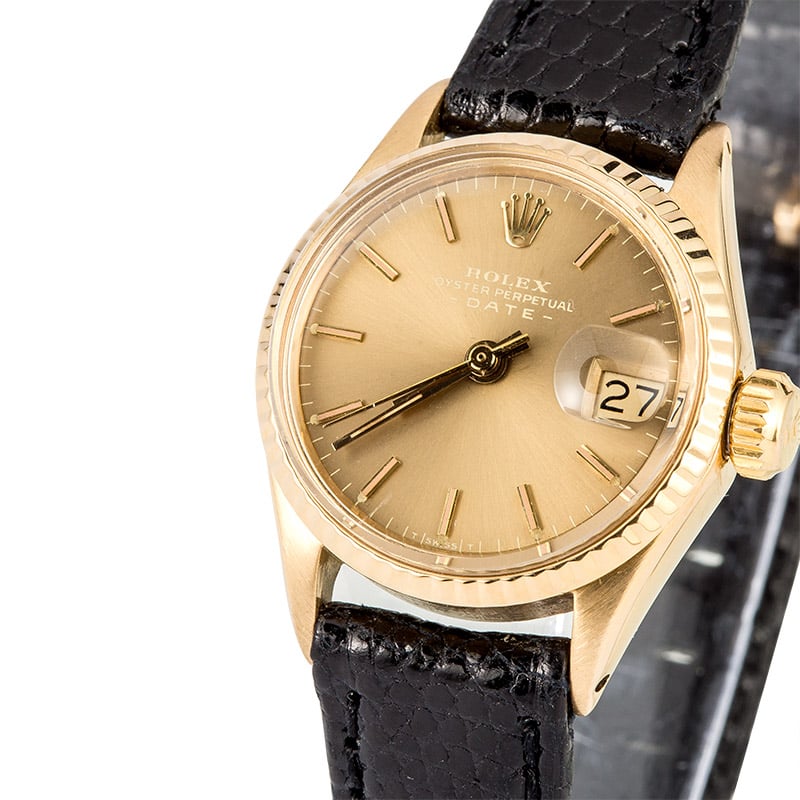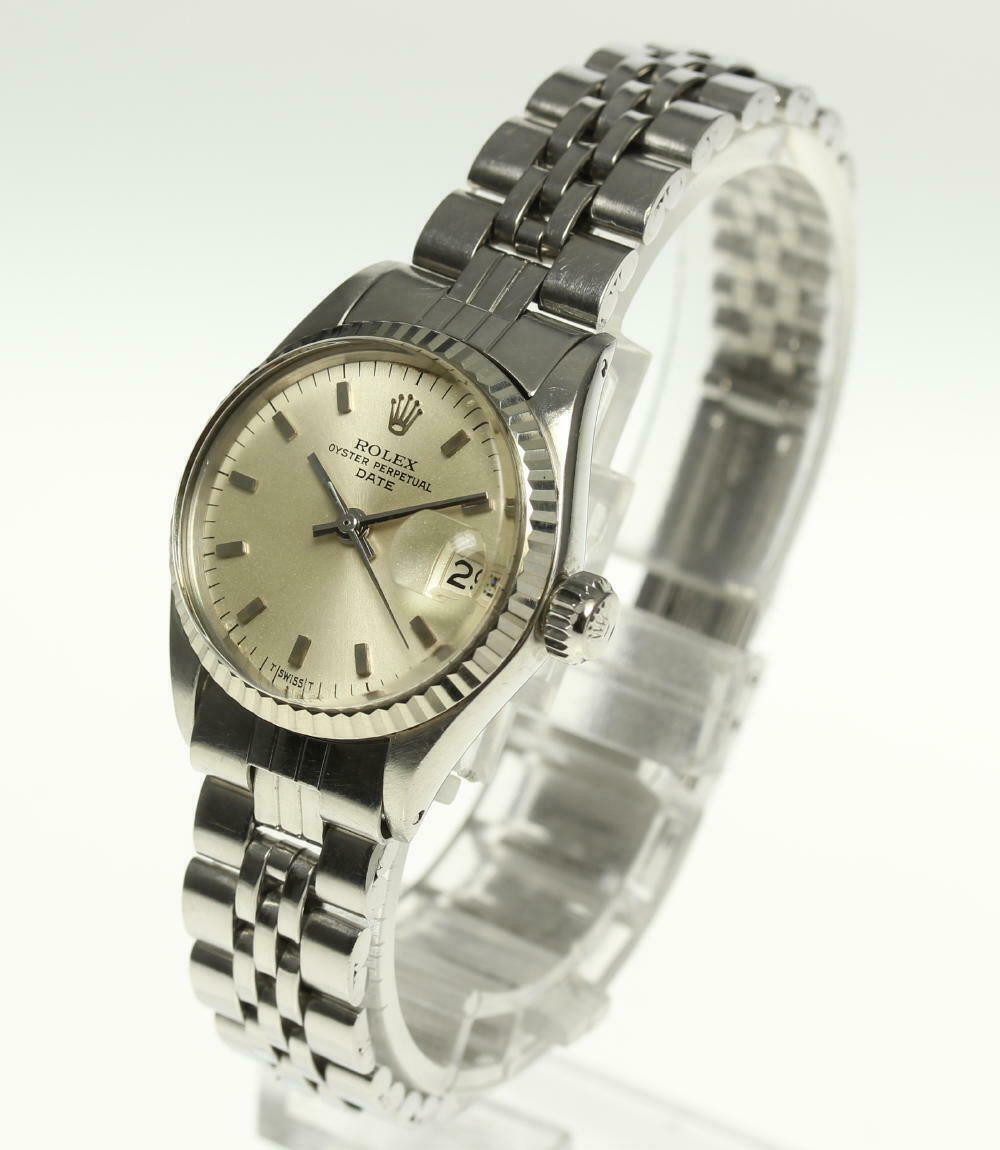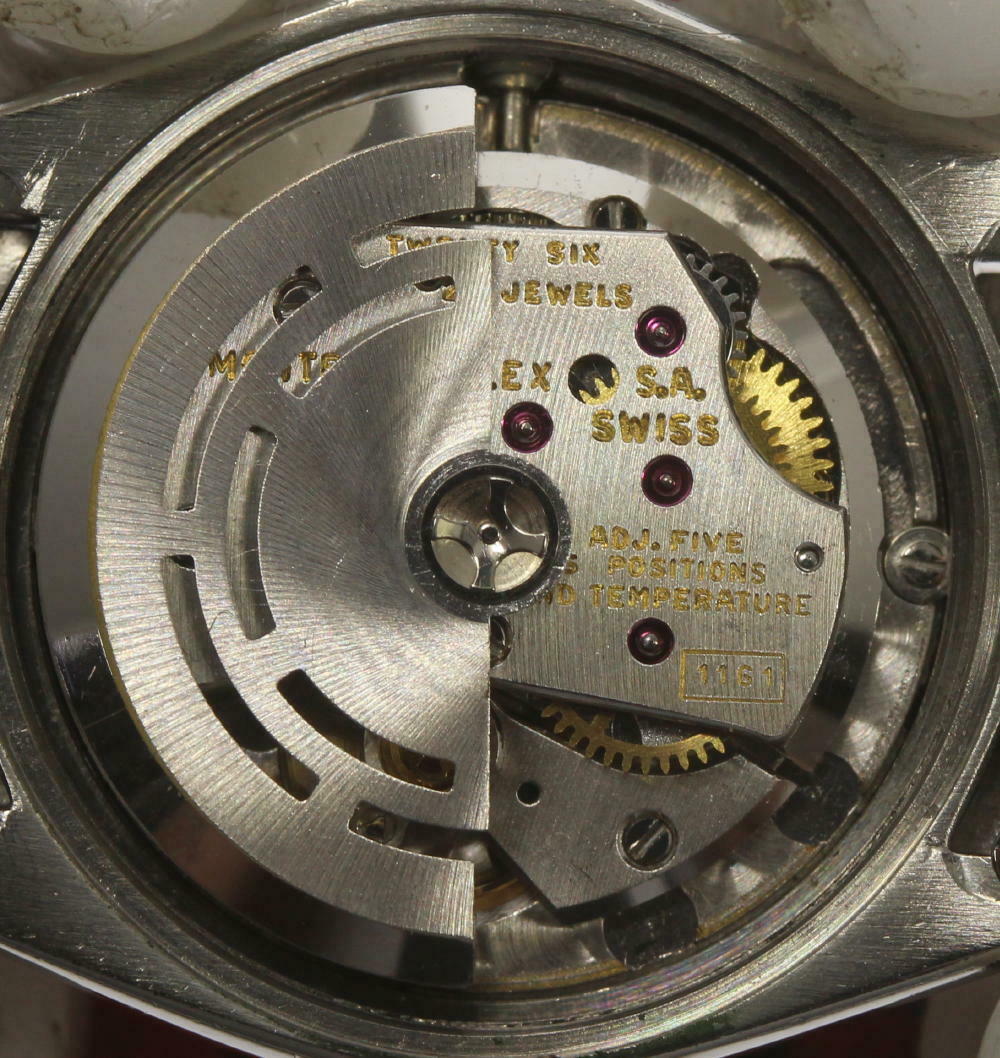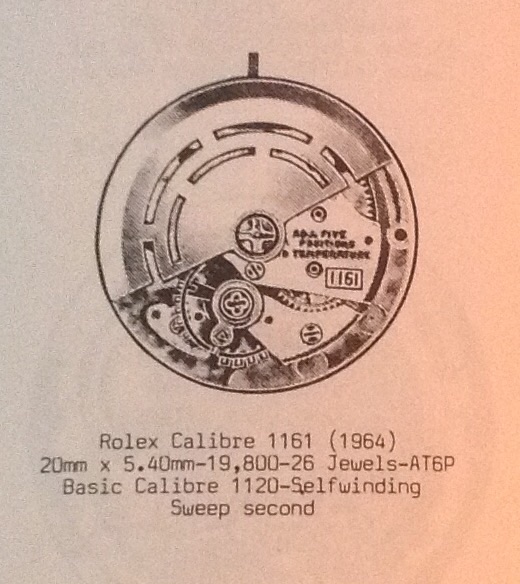Click to see the details
market
Click to see the details
history
| Name | 6517 |
| Family | Datejust |
| Gender | Ladies |
| Movement | Rolex 1161 (Details) |
| Years in Production | 1965 - 1966 |
| Case Diameter (mm) | 26 |
| Lug Width | 13 |
| Mechanism | Automatic |
| Chronometer | Yes |
| Hacking | Yes |
| Date Function | No |
| Quickset | No |
| Chronograph | No |
| Power Reserve (Hours) | 42 |
| Frequency (bph) | 19, 800 |
| Jewel Count | 26 |
| Second Hand | Sweep |
| Shape | Round |
| Hour Marks | Index |
| Date Position | 3 O'Clock |
| Crown Position | 3 O'Clock |
| Crystal Material | Acrylic |
| Band Replaceable | Yes |
Notes:
The model 6517 is a ladies Date model with a 26mm case. It uses the 1161 automatic movement and features a fluted bezel. The dial features index hour marks and can be champagne, blue or white. The case can be either stainless steel, 18K gold or a stainless case with a gold bezel. The bracelet is most typically a 5-link jubilee design in either stainless steel or a stainless/gold hybrid.
Mechanism:
The Cal. 1161 began service in 1964 in the ref. 6544, a midsize, steel example of the range, and ended in the early seventies in the ref. 6807. Rolex replaced this with the Cal. 1570, which introduced a seconds hacking feature. Although often regarded as the entry-level Rolex, and the watch that represents the buy in to the brand for new collectors, the Oyster Perpetual range still benefits from the same level of engineering excellence and attention to detail as anything else that bears the Rolex name, and nowhere more so than in its mechanism.
In addition, the Rolex 1161 is a chronometer certified movement, rated accurate to within -4/+6 seconds a day. Also, its free-sprung Nivarox hairspring features a Breguet overcoil, and it has a power reserve of 42 hours. Its balance wheel is regulated by Rolex’s Microstella system, two pairs of weighted screws on the inside of the balance rim that makes the wheel more aerodynamic and its adjustment easier to fine tune.
In addition, the Rolex 1161 is a chronometer certified movement, rated accurate to within -4/+6 seconds a day. Also, its free-sprung Nivarox hairspring features a Breguet overcoil, and it has a power reserve of 42 hours. Its balance wheel is regulated by Rolex’s Microstella system, two pairs of weighted screws on the inside of the balance rim that makes the wheel more aerodynamic and its adjustment easier to fine tune.
Family Notes:
The Datejust emerged in 1945, introducing the watch world to the innovative automatically changing date window. This feature made watch history and has since made the Datejust one of Rolex's most successful models. The ladies model that was introduced a few decades later has enjoyed a large amount of success as well, thanks to its functional yet luxurious design. The Rolex Datejust is the modern archetype of the classic watch, thanks to aesthetics and functions that transcend changes in fashion. Aesthetically, the Datejust has spanned eras, while retaining the enduring codes that make it, notably in its traditional versions, one of the most recognised and recognisable of watches.
Originally named the Jubilee Datejust, Rolex Datejust history began in 1945 when Rolex released the model for the company's 40th Anniversary. It was a direct descendant of the Bubbleback and included a date function, which was placed at the 3 o’clock position on the face. The Datejust had a coin-edge bezel, which later became the flutted bezel. It was the first watch to show the date automatically and also the first to change the displayed date at exactly midnight. The Datejust was innovative, unique, and different than any other watch offered at that time.
The history of Rolex Datejust begins with the first Datejust, the Jubilee Datejust Model 4467, which was only available in 18k gold and had a small bubbleback winder with a deeply domed back. In the 1950's, the Oysterdate joined the Datejust family, coming in two sizes. Although the Datejust originally consisted of three case parts, it was quickly updated to just two. Another major update was the addition of the Cyclops lens in 1954. Today this lens is standard to Rolex watches and even part of the brand’s signature. Before 1954, however, no one had used a magnifying bubble on the lens right above the date. Then, in 1957, a new, lighter, slimmer movement, the caliber 1065, allowed for a flattened case back in place of the old domed one. That same year, the Datejust became available in Steelium (stainless steel) in addition to the original gold. Other changes over the years included a flat dial (rather than curved) and the Rapid Date Change (aka quickset) feature.
The fact that Rolex Datejusts are still purchased and worn today is a testament to their enduring respectability and timelessness. To understand the Rolex Datejust history, pictures can be worth a thousand words. Seeing pictures of multiple presidents and other powerful people wearing the Rolex Datejust shows the importance and significance of this watch.
Originally named the Jubilee Datejust, Rolex Datejust history began in 1945 when Rolex released the model for the company's 40th Anniversary. It was a direct descendant of the Bubbleback and included a date function, which was placed at the 3 o’clock position on the face. The Datejust had a coin-edge bezel, which later became the flutted bezel. It was the first watch to show the date automatically and also the first to change the displayed date at exactly midnight. The Datejust was innovative, unique, and different than any other watch offered at that time.
The history of Rolex Datejust begins with the first Datejust, the Jubilee Datejust Model 4467, which was only available in 18k gold and had a small bubbleback winder with a deeply domed back. In the 1950's, the Oysterdate joined the Datejust family, coming in two sizes. Although the Datejust originally consisted of three case parts, it was quickly updated to just two. Another major update was the addition of the Cyclops lens in 1954. Today this lens is standard to Rolex watches and even part of the brand’s signature. Before 1954, however, no one had used a magnifying bubble on the lens right above the date. Then, in 1957, a new, lighter, slimmer movement, the caliber 1065, allowed for a flattened case back in place of the old domed one. That same year, the Datejust became available in Steelium (stainless steel) in addition to the original gold. Other changes over the years included a flat dial (rather than curved) and the Rapid Date Change (aka quickset) feature.
The fact that Rolex Datejusts are still purchased and worn today is a testament to their enduring respectability and timelessness. To understand the Rolex Datejust history, pictures can be worth a thousand words. Seeing pictures of multiple presidents and other powerful people wearing the Rolex Datejust shows the importance and significance of this watch.
Item created by: gdm
on 2018-10-01 11:24:59
Last edited by: gdm on 2019-07-30 18:39:35
If you see errors or missing data in this entry, please feel free to log in and edit it. Anyone with a Gmail account can log in instantly.
Last edited by: gdm on 2019-07-30 18:39:35
If you see errors or missing data in this entry, please feel free to log in and edit it. Anyone with a Gmail account can log in instantly.





